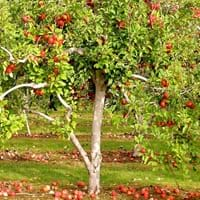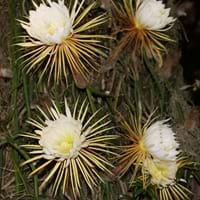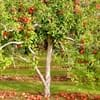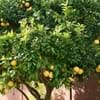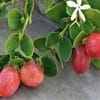Life Span
Perennial
Perennial
Type
Flowering Plants, Fruits, Trees
Cactus, Flowering Plants
Origin
Central Asia
South America, Argentina, Brazil
Types
Aceymac apple, Bailey Sweet apple, Dabinett apple, Nehou apple
Not available
Number of Varieties
Not Available
Habitat
Hillside
Dry Forest, limestone outcrops, Subtropical climates
USDA Hardiness Zone
5-8
10-14
Sunset Zone
A1, A2, A3, 8, 9, 10, 11, 12, 13, 14, 15, 16, 17, 18, 19, 20, 21, 22, 23, 24
H2, 13, 16, 17, 21, 22, 23, 24
Habit
Oval or Rounded
Upright/Erect
Flower Color
White
White, Light Green
Flower Color Modifier
Not Available
Bicolor
Fruit Color
Green, Red
Orange, Pink, White, Yellow
Leaf Color in Spring
Dark Green
Not Available
Leaf Color in Summer
Green
Not Available
Leaf Color in Fall
Brown, Green, Light Yellow
Not Available
Leaf Color in Winter
Not Available
Not Available
Leaf Shape
Oblong
Not Available
Plant Season
Spring
Spring, Summer, Fall, Winter
Sunlight
Full Sun, Partial shade
Full Sun
Type of Soil
Loamy
Loam, Sand
The pH of Soil
Neutral
Acidic, Neutral, Alkaline
Soil Drainage
Well drained
Well drained
Bloom Time
Fall, Summer
Late Spring, Early Summer
Tolerances
Drought
Drought, Salt
Where to Plant?
Ground
Container, Ground
How to Plant?
Grafting, Seedlings, Transplanting
Cuttings
Plant Maintenance
Medium
Medium
Watering Requirements
Medium
Average Water Needs, Distilled Water, Needs good drainage
In Summer
Lots of watering
Lots of watering
In Spring
Moderate
Moderate
In Winter
Average Water
Average Water
Soil pH
Neutral
Acidic, Neutral, Alkaline
Soil Type
Loamy
Loam, Sand
Soil Drainage Capacity
Well drained
Well drained
Sun Exposure
Full Sun, Partial shade
Full Sun
Pruning
Prune when plant is dormant, Remove dead or diseased plant parts
Remove damaged leaves, Remove dead branches, Remove dead leaves
Fertilizers
All-Purpose Liquid Fertilizer
All-Purpose Liquid Fertilizer
Pests and Diseases
Aphids, Canker, Caterpillars, Powdery mildew, Root rot
Bacterial Stem Rot, Mealy bugs, Red spider mite, Scale
Plant Tolerance
Drought
Drought
Flower Petal Number
Single
Semi-Double
Foliage Texture
Medium
Bold
Foliage Sheen
Matte
Not Available
Attracts
Birds
Birds, Spider Mites
Allergy
Mouth itching, Throat itching
Avoid during Pregnancy, hallucinations
Aesthetic Uses
Not Used For Aesthetic Purpose
Showy Purposes
Beauty Benefits
Not Available
Not Available
Environmental Uses
Air purification
Air purification
Medicinal Uses
Cancer, constipation, Diabetes, Diarrhea, Dysentry, Fever, Heart problems, Tooth ache
Antidiabetic, Rheumatism, Soothing and relieving pain
Part of Plant Used
Fruits
Flowers, Leaves
Other Uses
Used As Food, Wood is used for making furniture
Traditional medicine, Used for its medicinal properties, Used in herbal medicines
Used As Indoor Plant
No
Yes
Used As Outdoor Plant
Yes
Yes
Garden Design
Fruit / Fruit Tree, Shade Trees, Showy Tree
Container, Edible, Hedges, Houseplant, Rock Garden, Wall, Tropical
Botanical Name
Malus domestica
Selenicereus grandiflorus
Common Name
Apple Tree
Queen of the night, large-flowered cactus, sweet-scented cactus, vanilla cactus
In Hindi
सेब का वृक्ष
रात की रानी
In German
Apfelbaum
Königin der Nacht
In French
Pommier
Reine de la nuit
In Spanish
Manzano
Reina de la noche
In Greek
μηλιά
Βασίλισσα της νύχτας
In Portuguese
Macieira
Rainha da noite
In Polish
jabłoń
Królowa nocy
In Latin
Arbore
Domina noctis
Phylum
Magnoliophyta
Magnoliophyta
Class
Magnoliopsida
Magnoliopsida
Order
Rosales
Caryophyllales
Family
Rosaceae
Cactaceae
Clade
Angiosperms, Eudicots, Rosids
Angiosperms, Core eudicots, Eudicots
Tribe
Not Available
Hylocereeae
Subfamily
Not Available
Cactoideae
Number of Species
Not Available
Importance of Apple Tree and Queen of the Night
Want to have the most appropriate plant for your garden? You might want to know the importance of Apple Tree and Queen of the Night. Basically, these two plants vary in many aspects. Compare Apple Tree and Queen of the Night as they differ in many characteristics such as their life, care, benefits, facts, etc. Every gardener must at least have the slightest clue about the plants he wants to plant in his garden. Compare their benefits, which differ in many ways like facts and uses. The medicinal use of Apple Tree is Cancer, constipation, Diabetes, Diarrhea, Dysentry, Fever, Heart problems and Tooth ache whereas of Queen of the Night is Antidiabetic, Rheumatism and Soothing and relieving pain. Apple Tree has beauty benefits as follows: Not Available while Queen of the Night has beauty benefits as follows: Not Available.
Compare Facts of Apple Tree vs Queen of the Night
How to choose the best garden plant for your garden depending upon its facts? Here garden plant comparison will help you to solve this query. Compare the facts of Apple Tree vs Queen of the Night and know which one to choose. As garden plants have benefits and other uses, allergy is also a major drawback of plants for some people. Allergic reactions of Apple Tree are Mouth itching and Throat itching whereas of Queen of the Night have Avoid during Pregnancy and hallucinations respectively. Having a fruit bearing plant in your garden can be a plus point of your garden. Apple Tree has showy fruits and Queen of the Night has showy fruits. Also Apple Tree is flowering and Queen of the Night is not flowering . You can compare Apple Tree and Queen of the Night facts and facts of other plants too.
